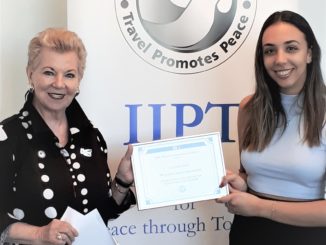Developing Sustainable Destinations – Personal Reflection on the future

Tourism debates are often highly contentious, classified as wicked problems where conflicts between stakeholders are inherent and diverse. To achieve mutually beneficial, peaceful, and sustainable outcomes, it is essential for key stakeholders to engage in collaborative dialogues. But for these to be successful, and for tourism to be recognised as a force for change, important prerequisites exist. First, there is a need to define what peace means to us and how we can achieve it. Secondly, we must cultivate not only technical skills but soft skills including collective leadership, communication, and empathy to facilitate meaningful debates. In doing so, peaceful and sustainable outcomes can be achieved as these two concepts are inextricably connected. Thus, soft skills will play a key role for individuals both in the tourism industry and beyond, including myself, which I shall conclude with.
To establish the skills necessary to resolve stakeholder tensions and achieve peace through tourism, we must define the peace we seek to create. Galtung (1969) distinguishes between positive and negative peace, describing peace as more than merely the absence of war. A successful tourism industry demands civil peace, safety, and security, and is thus dependent on peace for survival (Becken & Carmignani 2016). However, this is not enough to secure the sustainability of the sector. A more holistic conceptualisation of peace is ‘positive peace,’ embodying the presence of desirable conditions in society, including wellbeing, equity, and justice (Haessly 2010). Such an approach manifests peace as a presence in the world, one which each individual can actively work towards to entrench peace within society (Rees & Blachard 1999; Moufakkir & Kelly 2010). If such an attitude is manifested within tourism, the higher purpose of the industry can be materialised, and tourism can become a powerful vehicle for peace (Young 2019). This is espoused within the IIPT’s vision of tourism as ‘The World’s First Global Peace Industry,’ where every individual has the opportunity to act as an ambassador for peace (IIPT 2020). But most significantly, their ‘Credo of the Peaceful Traveller’ states that peace begins with the individual (IIPT 2020). Thus, as we establish positive peace as the basis of a thriving tourism sector, we cannot overlook the role of the individual in attaining and maintaining peace, thus cultivating soft skills is essential.
While peace begins with the individual, it must be supported by broader peace-building strategies (Smith 2004). This puts an onus on tourism stakeholders, from destination management organisations to communities and tourists to engage in leadership, particularly collective leadership (Wohlmuther & Wintersteiner 2014). At the core of collective leadership is the idea that a group of leaders can contribute to a more sustainable future by assuming flexible and joint leadership for the benefit of all (Kuenkel, Gerlach & Frieg 2011). Thus, while the individual aspect of leadership as a soft skill is important, more effective outcomes are achieved through a collective mindset. This is affirmed by Hemmati (2007), who believes the value of stakeholder dialogues is derived from collective leadership, transparency, equity, and universal participation. If such elements are embedded within dialogues, participants can gain deeper understandings of multiple stakeholder perspectives. Additionally, sustainability leadership does not mean we need business or political backgrounds, it simply advocates for leaders to exemplify the willingness, ability, and strength to contribute to sustainability debates (Wohlmuther & Wintersteiner 2014). Thus, any stakeholder exhibiting these qualities can become a powerful leader in sustainable, and peace tourism. Thus, collective leadership involving multiple stakeholders enables the achievement of more peaceful and sustainable outcomes by providing opportunities for more creative and innovative solutions (Dimmock & Musa 2015).
Central to peace tourism debates is the concept of the ‘contact hypothesis’ as the means to attain peace. Tourism at its core advocates the exploration of new civilisations and cultures (Becken & Carmignani 2016). Hence, it can be interpreted as a mind-broadening experience with the potential to enhance cross-cultural understanding, breaking down political and ideological barriers (Kim, Prideaux & Prideaux 2007). This is exhibited within the IIPT’s mission which conceptualises tourism as a mechanism for peace through promoting international understanding and cooperation between nations (IIPT 2020). After all, peace is multi-faceted in nature, requiring the participation of multiple stakeholders (Moufakkir & Kelly 2010). This implicates the value of communication skills for peace to flourish. Cross-cultural communication builds respect for differences. In particular, understanding the language of nonviolence is a critical skill, as it implies the attainment of knowledge and understanding of comparative values and beliefs (Blanchard & Higgins-Desbiolles 2013). In communicating through the language of nonviolence, we can gain a more inclusive understanding of what peace means to different people. Additionally, communication allows us to articulate our vision to other stakeholders (Boulding 1992). After all, if we cannot articulate our vision of what a peaceful world entails, we cannot engage in collaborative actions to promote, preserve, and sustain a culture of peace. Thus, through communication, we can develop understandings of a multitude of perspectives and articulate our vision, which enables more inclusive, dynamic, and collaborative responses.
Empathy, problem-solving and critical thinking are deeply intertwined soft skills essential in resolving stakeholder conflict. Problem-solving, when restricted to the application of knowledge and technology can only get us so far. Richmond (2008) reminds us of the need to move beyond political conceptualisations of peace focusing on power and instead engage with emotive, aesthetic, and linguistic skills to resolve conflicts and achieve peace. Thus, we must prioritise intangibles like empathy and our emotional intelligence. To practice empathy, the notion of trans-perceptual learning is integral. This refers to learning that derives from perceiving reality from the perspective of others, or ‘walking in another’s’ shoes (Crews 1989). In doing so, individuals can engage in the process of ‘conscientisation’ to think critically and gain a deeper understanding of different stakeholder perspectives on the means for social and peaceful change (Freire 1970). By continually questioning our attitudes, this enables us to respond to a diversity of stakeholder opinion, and even conflict, with appreciation and respect rather than ignorance, which spreads tolerance and leads to the development of more creative solutions to resolving tensions (Blanchard & Higgins-Desbiolles 2013).
The fundamental building blocks of peace tourism and sustainability leadership are inextricably connected. It has been established that peace in tourism benefits when a variety of stakeholder perspectives are considered. Similarly, the UNWTO (2020) frames sustainable tourism as requiring the participation of all relevant stakeholders and strong leadership to facilitate consensus building. Additionally, ecological, social, and economic perspectives are considered the building blocks of sustainability (Saarinen 2006), and peace dividends. Peace is also considered as one of the five indicators of sustainability (Buckley 2012). According to Wohlmuther and Wintersteiner (2014), the concepts of peace and sustainability cannot be separated, as most of their constituting elements have peace-building effects. Economically, tourism generates income, employment, and poverty reduction (Levy & Hawkins 2010). The ecological perspective is represented through initiatives like recycling and education programs. Most notably, the IIPT’s Peace Parks act as tangible representations of the commitment to build a culture of peace, echoing environmental, cultural, and reconciliation values (IIPT 2020). The final pillar of sustainability, the social perspective, is achieved through promoting cross-cultural understanding, which underpins peace tourism debates. Each of these pillars is reflected within the IIPT’s mission – including poverty reduction, improved quality of environment, and cultural enhancement and reconciliation (IIPT 2020). Thus, as sustainability leadership seeks to evaluate various stakeholder positions on economic, ecological, and social issues, tourism can, in very similar ways, play a role in sustaining peace.
I’d now like to reflect on the role that soft skills will play in my career. As a Bachelor of Business student, I’ve studied subjects including accounting and finance, focusing on technical know-how. But through tourism subjects, I’ve gained insight into the ingredients to succeed in a business career, understanding that technical competence will only get me so far. Soft skills are what will allow me to succeed in solving practical problems by engaging with a multitude of stakeholders. Currently, I’m studying marketing, international business, and tourism, leading me to a career in international tourism marketing, where soft skills are essential. Marketing involves creating, communicating, and delivering value propositions. In tourism, this means creating and selling travel experiences.
Soft skills are specifically important in the product and promotion elements of the tourism destination marketing mix. In market research and product design, I will need a strong sense of empathy to understand the mindset of the target market on a personal level. In thinking critically to incorporate consumer insights into product development, I, as a marketer will be in a better position to meet the needs and desires of consumers. In tourism especially, empathy will allow me to understand the variety of tourist motivations, and in turn, develop satisfactory travel experiences.
Promotion rests of three elements: inform, persuade, remind. For myself as a marketer to capture consumer interest, effective communication is undoubtedly a prerequisite, because no matter the inherent value of a travel product, a sale won’t be made unless promotions spark consumer interest. Through communication, tourism marketing can also contribute to its higher purpose, rather than being limited to materialistic pursuits. Looking at the IIPT’s website, they are not promoting products, but the value of meaningful interactions and peace-building opportunities. In developing promotional materials, I would like to focus on bringing tourism back to its core, which I believe is people. If I can communicate the value of guest-host interactions, I believe I can market a more enriching experience, and become part of tourism’s higher purpose, which is inherent within the values of the IIPT. Additionally, my communication skills at a simpler level will allow me to work alongside others in the industry to articulate my vision for peace in tourism marketing.
The notion of collective leadership is also key for me to succeed because, in an international context, I will be working with tourism stakeholders and leaders around the world. By engaging in collective leadership, this will help me to contribute to peace and sustainability outcomes. Working with others, as aforementioned, can lead to more sustainable outcomes by harnessing greater creativity and innovation when leaders bring their minds together. This is especially important when looking to the future of my career and many others, where issues of sustainability are increasingly relevant. Specifically, within tourism marketing, advocating more sustainable forms of tourism like ecotourism and community-based tourism could likely change tourism for the better, as the interests of tourists seeking an enriching experience can align with pathways for achieving peace and sustainability, thereby increasing opportunities for the value propositions I can create.
Marie Janssen
UTS Business School Student
References
Becken, S. & Carmignani, F. 2016, ‘Does tourism lead to peace?’, Annals of Tourism Research, vol. 61, no. 1, pp. 63-79.
Blanchard, L. & Higgins-Desbiolles, F. 2013, Peace through tourism: promoting human security through international citizenship, 1st edn, Routledge, Oxfordshire, pp. 1-97.
Boulding, E. 1992, New agendas for peace research: conflict and security re-examined, 1st edn, Lynne Rienner Publishers, Boulder, pp. 7-21.
Buckley, R. 2012, ‘Sustainable tourism: research and reality’, Annals of Tourism Research, vol. 39, no. 2, pp. 528-544.
Crews, R. 1989, ‘A values-based approach to peace studies’, in D. Thomas & M. Klare (eds), Peace and world order studies: a curriculum guide, 5th edn, Westview Press, Boulder, pp. 28-37.
Dimmock, K. & Musa, G. 2015, ‘Scuba diving tourism system: a framework for collaborative management and sustainability’, Marine Policy, vol. 54, no. 1, pp. 52-58.
Freire, P. 1970, Pedagogy of the oppressed, 1st edn, The Continuum Publishing Company, New York, pp. 78-89.
Galtung, J. 1969, ‘Violence, peace and peace research’, Journal of Peace Research, vol. 6, no. 3, pp. 167-191.
Haessly, J. 2010, ‘Tourism and a culture of peace’, in O. Moufakkir & I. Kelly (eds), Tourism, progress and peace, 1st edn, CAB International, Wallingford, pp. 1-14.
Hemmati, M. 2007, ‘Multistakeholder partnerships’, in S. Scherr & J. McNeely (eds), Farming with nature – the art and science of ecoagriculture, 1st edn, Island Press, Washington, pp. 344-357.
IIPT 2020, Global Peace Parks project, Peace Tourism, viewed 12 May 2020, <https://peacetourism.org/peace-parks-project/>.
IIPT 2020, IIPT Credo of the Peaceful Traveller, IIPT, viewed 7 May 2020, <http://www.iipt.org/credo.html>.
IIPT 2020, Vision and mission, Peace Tourism, viewed 7 May 2020, <https://peacetourism.org/vision-and-mission/>.
Kim, S., Prideaux, B. & Prideaux, J. 2007, ‘Using tourism to promote peace on the Korean Peninsula’, Annals of Tourism Research, vol. 34, no. 2, pp. 291-309.
Kuenkel, P., Gerlach, S. & Frieg, V. 2011, Stakeholder dialogues, key concepts and competencies for achieving common goals, a practical guide for change agents from public sector, private sector and civil society, 1st edn, Collective Leadership Institute, Potsdam, pp. 25-32.
Levy, S. & Hawkins, D. 2010, ‘Peace through tourism: commerce based principles and practices’, Journal of Business Ethics, vol. 89, no. 1, pp. 569-585.
Moufakkir, O. & Kelly, I. 2010, Tourism, progress and peace, 1st edn, CAB International, Wallingford, pp. XVI – 83.
Rees, S. & Blanchard, L. 1999, ‘Security through international citizenship’, in M. Tehranian (ed.), Worlds apart: human security and global governance, 1st edn, I.B. Tauris, London, pp. 168-178.
Richmond, O. 2008, ‘Reclaiming peace in international relations’, Millennium: Journal of International Studies, vol. 36, no. 3, pp. 439-470.
Saarinen, J. 2006, ‘Traditions of sustainability in tourism studies’, Annals of Tourism Research, vol. 33, no. 4, pp. 1121-1140.
Smith, D. 2004, Towards a strategic framework for peacebuilding: getting their act together, Overview report of the joint Utstein study of peacebuilding, International Peace Research Institute, Oslo, pp. 10-13.
UNWTO 2020, Sustainable development, UNWTO, viewed 9 May 2020, <https://www.unwto.org/sustainable-development>.
Wohlmuther, C. & Wintersteiner, W. 2014, International handbook on tourism and peace, 1st edn, Drava Verlag, Klagenfurt, pp. 1-184.
Young, T. 2019, International Day of Peace 2019 – tourism as a vehicle of peace, Peace Tourism, viewed 7 May 2020, <https://peacetourism.org/international-day-of-peace-2019/>.



